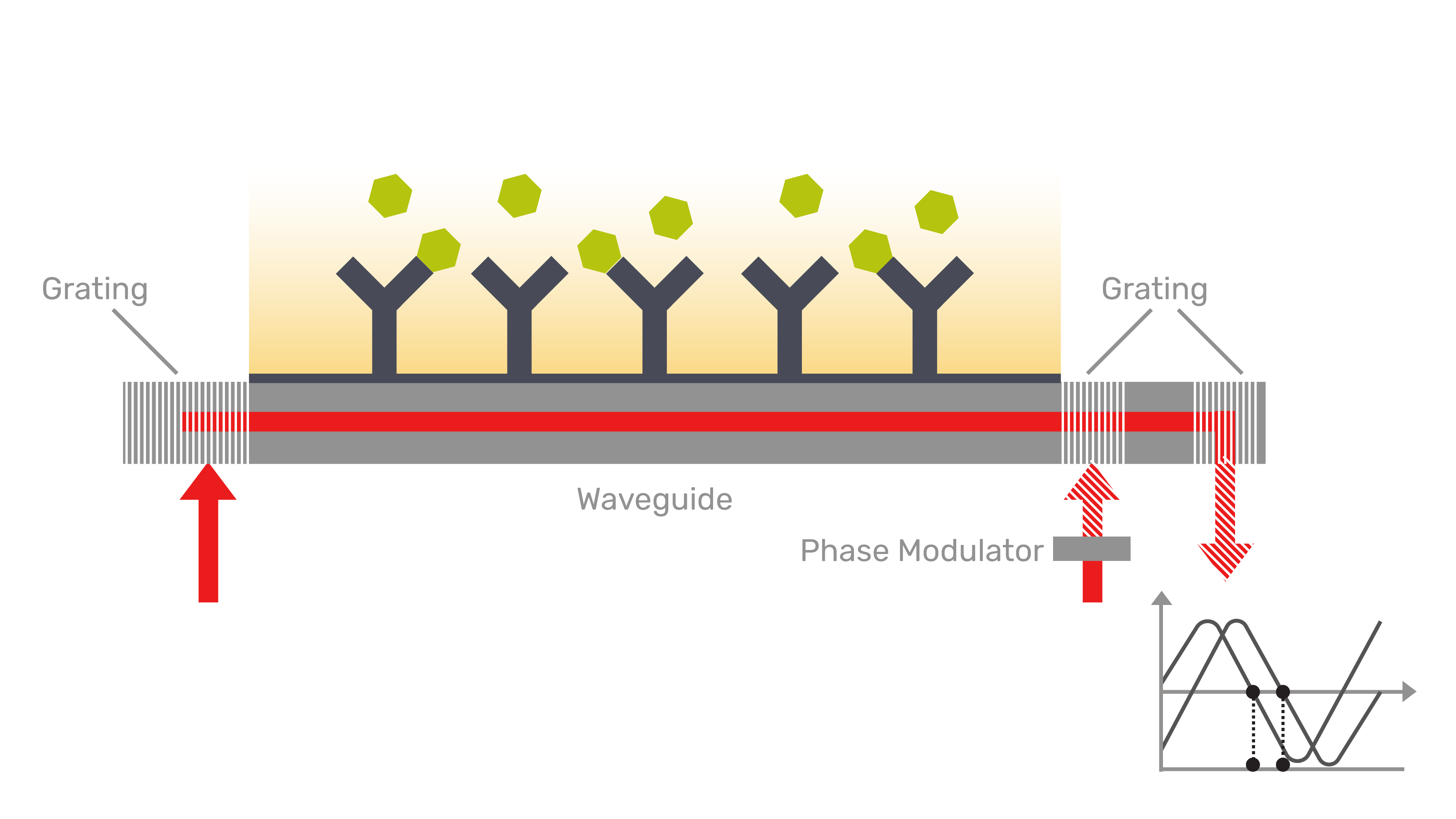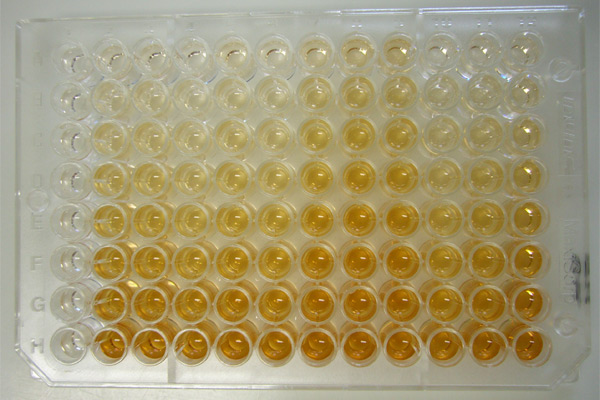|
Grating-coupled Interferometry
Grating-coupled interferometry (GCI) is a biophysical characterization method mainly used in biochemistry and drug discovery for label-free analysis of molecular interactions. Similar to other optical methods such as surface plasmon resonance (SPR) or bio-layer interferometry (BLI), it is based on measuring refractive index changes within an evanescent field near a sensor surface. After immobilizing a target to the sensor surface, analyte molecules in solution which bind to that target cause a small increase in local refractive index. By monitoring these refractive changes over time characteristics such as kinetic rates and affinity constants of the analyte-target binding, or analyte concentrations, can be determined. Explanation GCI is based on phase-shifting waveguide interferometry. Light of the sensing arm of the interferometer is coupled into a monomode waveguide through a first grating, and undergoes a phase change until it reaches a second grating, depending on the loca ... [...More Info...] [...Related Items...] OR: [Wikipedia] [Google] [Baidu] |
Biophysics
Biophysics is an interdisciplinary science that applies approaches and methods traditionally used in physics to study biological phenomena. Biophysics covers all scales of biological organization, from molecular to organismic and populations. Biophysical research shares significant overlap with biochemistry, molecular biology, physical chemistry, physiology, nanotechnology, bioengineering, computational biology, biomechanics, developmental biology and systems biology. The term ''biophysics'' was originally introduced by Karl Pearson in 1892. Roland Glaser. Biophysics: An Introduction'. Springer; 23 April 2012. . The term ''biophysics'' is also regularly used in academia to indicate the study of the physical quantities (e.g. electric current, temperature, stress, entropy) in biological systems. Other biological sciences also perform research on the biophysical properties of living organisms including molecular biology, cell biology, chemical biology, and bioche ... [...More Info...] [...Related Items...] OR: [Wikipedia] [Google] [Baidu] |
Ligand Binding Assay
A ligand binding assay (LBA) is an assay, or an analytic procedure, which relies on the binding of ligand molecules to receptors, antibodies or other macromolecules. A detection method is used to determine the presence and amount of the ligand-receptor complexes formed, and this is usually determined electrochemically or through a fluorescence detection method. This type of analytic test can be used to test for the presence of target molecules in a sample that are known to bind to the receptor. There are numerous types of ligand binding assays, both radioactive and non-radioactive.Joseph R. Lakowicz. (1991) Topics in Fluorescence Spectroscopy: Biochemical applications. Some newer types are called "mix-and-measure" assays because they require fewer steps to complete, for example foregoing the removal of unbound reagents. Ligand binding assays are used primarily in pharmacology for various demands. Specifically, despite the human body's endogenous receptors, hormones, and other n ... [...More Info...] [...Related Items...] OR: [Wikipedia] [Google] [Baidu] |
Forensic Techniques
Forensic science combines principles of law and science to investigate criminal activity. Through crime scene investigations and laboratory analysis, forensic scientists are able to link suspects to evidence. An example is determining the time and cause of death through autopsies. This evidence can then be used for proof towards a crime. Forensic science, often confused with criminalistics, is the application of science principles and methods to support legal decision-making in matters of criminal and civil law. During criminal investigation in particular, it is governed by the legal standards of admissible evidence and criminal procedure. It is a broad field utilizing numerous practices such as the analysis of DNA, fingerprints, bloodstain patterns, firearms, ballistics, toxicology, microscopy, and fire debris analysis. Forensic scientists collect, preserve, and analyze evidence during the course of an investigation. While some forensic scientists travel to the scene of the ... [...More Info...] [...Related Items...] OR: [Wikipedia] [Google] [Baidu] |
Biochemistry Methods
The following outline is provided as an overview of and topical guide to biochemistry: Biochemistry – study of chemical processes in living organisms, including living matter. Biochemistry governs all living organisms and living processes. Applications of biochemistry * Testing ** Ames test – salmonella bacteria is exposed to a chemical under question (a food additive, for example), and changes in the way the bacteria grows are measured. This test is useful for screening chemicals to see if they mutate the structure of DNA and by extension identifying their potential to cause cancer in humans. ** Pregnancy test – one uses a urine sample and the other a blood sample. Both detect the presence of the hormone human chorionic gonadotropin (hCG). This hormone is produced by the placenta shortly after implantation of the embryo into the uterine walls and accumulates. ** Breast cancer screening – identification of risk by testing for mutations in two genes ... [...More Info...] [...Related Items...] OR: [Wikipedia] [Google] [Baidu] |
Spectroscopy
Spectroscopy is the field of study that measures and interprets electromagnetic spectra. In narrower contexts, spectroscopy is the precise study of color as generalized from visible light to all bands of the electromagnetic spectrum. Spectroscopy, primarily in the electromagnetic spectrum, is a fundamental exploratory tool in the fields of astronomy, chemistry, materials science, and physics, allowing the composition, physical structure and electronic structure of matter to be investigated at the atomic, molecular and macro scale, and over astronomical distances. Historically, spectroscopy originated as the study of the wavelength dependence of the absorption by gas phase matter of visible light dispersed by a prism. Current applications of spectroscopy include biomedical spectroscopy in the areas of tissue analysis and medical imaging. Matter waves and acoustic waves can also be considered forms of radiative energy, and recently gravitational waves have been associa ... [...More Info...] [...Related Items...] OR: [Wikipedia] [Google] [Baidu] |
Nanotechnology
Nanotechnology is the manipulation of matter with at least one dimension sized from 1 to 100 nanometers (nm). At this scale, commonly known as the nanoscale, surface area and quantum mechanical effects become important in describing properties of matter. This definition of nanotechnology includes all types of research and technologies that deal with these special properties. It is common to see the plural form "nanotechnologies" as well as "nanoscale technologies" to refer to research and applications whose common trait is scale. An earlier understanding of nanotechnology referred to the particular technological goal of precisely manipulating atoms and molecules for fabricating macroscale products, now referred to as molecular nanotechnology. Nanotechnology defined by scale includes fields of science such as surface science, organic chemistry, molecular biology, semiconductor physics, energy storage, engineering, microfabrication, and molecular engineering. The associated rese ... [...More Info...] [...Related Items...] OR: [Wikipedia] [Google] [Baidu] |
Electromagnetism
In physics, electromagnetism is an interaction that occurs between particles with electric charge via electromagnetic fields. The electromagnetic force is one of the four fundamental forces of nature. It is the dominant force in the interactions of atoms and molecules. Electromagnetism can be thought of as a combination of electrostatics and magnetism, which are distinct but closely intertwined phenomena. Electromagnetic forces occur between any two charged particles. Electric forces cause an attraction between particles with opposite charges and repulsion between particles with the same charge, while magnetism is an interaction that occurs between charged particles in relative motion. These two forces are described in terms of electromagnetic fields. Macroscopic charged objects are described in terms of Coulomb's law for electricity and Ampère's force law for magnetism; the Lorentz force describes microscopic charged particles. The electromagnetic force is responsible for ma ... [...More Info...] [...Related Items...] OR: [Wikipedia] [Google] [Baidu] |
Label-free Quantification
Label-free quantification is a method in mass spectrometry that aims to determine the relative amount of proteins in two or more biological samples. Unlike other methods for protein quantification, label-free quantification does not use a stable isotope containing compound to chemically bind to and thus label the protein. Implementation Label-free quantification may be based on precursor signal intensity or on spectral counting. The first method is useful when applied to high precision mass spectra, such as those obtained using the new generation of time-of-flight (ToF), fourier transform ion cyclotron resonance (FTICR), or Orbitrap mass analyzers. The high-resolution power facilitates the extraction of peptide signals on the MS1 level and thus uncouples the quantification from the identification process. In contrast, spectral counting simply counts the number of spectra identified for a given peptide in different biological samples and then integrates the results for all measu ... [...More Info...] [...Related Items...] OR: [Wikipedia] [Google] [Baidu] |
Immunoassay
An immunoassay (IA) is a biochemical test that measures the presence or concentration of a macromolecule or a small molecule in a solution through the use of an antibody (usually) or an antigen (sometimes). The molecule detected by the immunoassay is often referred to as an "analyte" and is in many cases a protein, although it may be other kinds of molecules, of different sizes and types, as long as the proper antibodies that have the required properties for the assay are developed. Analytes in biological liquids such as blood plasma, serum or urine are frequently measured using immunoassays for medical and research purposes. Immunoassays come in many different formats and variations. Immunoassays may be run in multiple steps with reagents being added and washed away or separated at different points in the assay. Multi-step assays are often called separation immunoassays or heterogeneous immunoassays. Some immunoassays can be carried out simply by mixing the reagents and samples an ... [...More Info...] [...Related Items...] OR: [Wikipedia] [Google] [Baidu] |
Ligand (biochemistry)
In biochemistry and pharmacology, a ligand is a substance that forms a complex with a biomolecule to serve a biological purpose. The etymology stems from Latin ''ligare'', which means 'to bind'. In protein-ligand binding, the ligand is usually a molecule which produces a signal by binding to a site on a target protein. The binding typically results in a change of conformational isomerism (conformation) of the target protein. In DNA-ligand binding studies, the ligand can be a small molecule, ion, or protein which binds to the DNA double helix. The relationship between ligand and binding partner is a function of charge, hydrophobicity, and molecular structure. Binding occurs by intermolecular forces, such as ionic bonds, hydrogen bonds and Van der Waals forces. The association or docking is actually reversible through dissociation. Measurably irreversible covalent bonding between a ligand and target molecule is atypical in biological systems. In contrast to the definition o ... [...More Info...] [...Related Items...] OR: [Wikipedia] [Google] [Baidu] |








